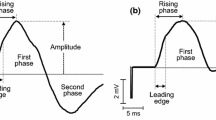Abstract
Using the volume conductor model, a single muscle fibre action potential can be expressed as a convolution of the transmembrane current and a weighting function. By simplifying the weighting function, the line source model is derived. We have developed similar expressions to compute the single muscle fibre action potential using simple models and physical considerations without any mathematical complexity. The relationship between the conduction velocity and amplitude is analysed and it is concluded that, for a given fibre, the amplitude is inversely proportional to the conduction velocity. This agrees with the experimental data reported in the literature.
The relation between amplitude and fibre diameter is studied. The amplitude increases with diameter owing to the increase in membrane current, but it is counteracted by the increase in conduction velocity. Because of the opposing effects, a point of inflection in the amplitude/diameter relationship is observed. Squareroot, square and linear dependencies of conduction velocity on fibre diameter were used. The difference in the peak-to-peak amplitude with these relationships is small and a linear relation between amplitude and fibre diameter seems reasonable irrespective of the conduction velocity/fibre diameter relationship.
The effect of lumping the transmembrane current at the axis of the fibre is discussed. This approximation results in an underestimation of the peak-to-peak amplitude near the surface, and the error is close to 50% for very large fibres. This error is accounted for in the model.
The recording distance at which the peak-to-peak amplitude of the signal is 100 μV is found to be 400 μm in the model. This is in good agreement with values obtained from a single-fibre electrode recording. The model is computationally fast and precise. It can easily be used with few modifications to simulate single fibre action potentials recorded using different electrodes.
Similar content being viewed by others
References
Adrian, E. D. andBronk, D. W. (1929) The discharge of impulses in motor nerve fibres. Part II. The frequency of discharge in reflex and voluntary contractions.J. Physiol.,67, 119–151.
Agarwal, G. C. andGottlieb, G. L. (1975) An analysis of electromyogram by fourier, simulation and experimental technique.IEEE Trans.,BME-22, 225–229.
Andreassen, S. andRosenfalck, A. (1981) Relationship of intracellular and extracellular action potential of skeletal muscle fibre. InCritical reviews in bioengineering, CRC Press Inc.6, 267–306.
Boyd, D. C., Lawrence, P. D. andBratty, P. J. A. (1978) On modelling the single motor unit potential.IEEE Trans.,BME-25, 236–243.
Brigham, E. (1974)Fast fourier transform. Prentice Hall, Englewood Cliff, New Jersey.
Buchthal, F., Guld, C. andRosenfalck, P. (1957) Multielectrode study of the territory of motor unit.Acta Physiol. Scand.,39, 83–104.
Ekstedt, J. (1964) Human single muscle fibre action potentials.Acta Physiol. Scand.,61, Suppl. 226, 1–96.
Geddes, L. A. andBaker, L. E. (1967) The specific resistance of biological material.Med. & Biol. Eng.,5, 271–293.
George, R. E. (1970) Summation of muscle fibre action potential.,8, 357–365.
Griep, P. A. M., Boon, K. L. andStegeman, D. F. (1978) A study of motor unit action potential by means of computer simulation.Biol. Cybernetics,30, 221–230.
Hakansson, C. H. (1956) conduction velocity and amplitude of action potential as related to circumference in the isolated fibre of frog muscle.Acta Physiol. Scand.,37, 14–34.
Hodgkin, A. L. (1954) A note on conduction velocity.J. Physiol.,125, 221–224.
Lindström, L. (1973) A model describing the power spectrum of myoelectric signal Part I: Single fibre signal. Technical report 5, 73 Chalmers University, Gothenburg.
Lorente, de No R. (1947) A study of nerve physiology. Studies of the Rockfeller Institute for Medical Research,132, 384–477.
Nygaard, E. (1981) Morfology og funktion i m. Biceps Brachii. (Thesis). Kopenhavns Universitet.
Plonsey, R. (1964) Volume conductor fields of action currents,Biophysics J.,4, 317–328.
Plonsey, R. (1974) The active fibre in a volume conductorIEEE. Trans.,BME-21, 371–381.
Plonsey, R. (1977) Action potential sources and their volume conductor fields.Proc. IEEE.,65, 601–611.
Rosenfalck, P. (1969) Intra and extracellular potential fields of active nerve and muscle fibres. A physiomathematical analysis of different models.Acta Physiol. Scand., Suppl 321, 1–168.
Rush, S., Abildskov, J. A. andMcFee, R. (1963) Resistivity of the body tissue at low frequencies.Circulation Res.,12, 40–50.
Stalberg, E. (1966) Propagation velocity in human muscle fibre in situ.Acta Physiol. Scand.,70, Suppl. 287.
St⇘lberg, E. andThiele, B. (1975) Motor units fibre density in the extensor digitorum communis muscle.J. Neurol. Neurosurg. & Psych. 38, 874–880.
St⇘lberg, E. andGath, I. E. (1979) Measurement of uptake area of small size electromyographic electrodes,IEEE Trans.,BME-26, 374–376.
St⇘lberg, E. andTrontelj, J. (1979)Single fibre electromyography. Mirvalle Press Ltd., Old Woking, Surrey, England.
St⇘lberg, E. andAntoni, L. (1980) The electrophysiological cross section of a motor unit.J. Neurol. Neurosurg. & Psych.,43, 469–474.
St⇘lberg, E. (1980) Macro EMG, a new recording technique.,43, 475–482.
Wani, A. andGuha, S. (1980) Synthesising of a motor unit potential based on the sequential firing of muscle fibres.Med. & Biol. Eng. & Comput.,18, 719–726.
Author information
Authors and Affiliations
Rights and permissions
About this article
Cite this article
Nandedkar, S.D., St⇘lberg, E. Simulation of single muscle fibre action potentials. Med. Biol. Eng. Comput. 21, 158–165 (1983). https://doi.org/10.1007/BF02441531
Received:
Accepted:
Issue Date:
DOI: https://doi.org/10.1007/BF02441531




